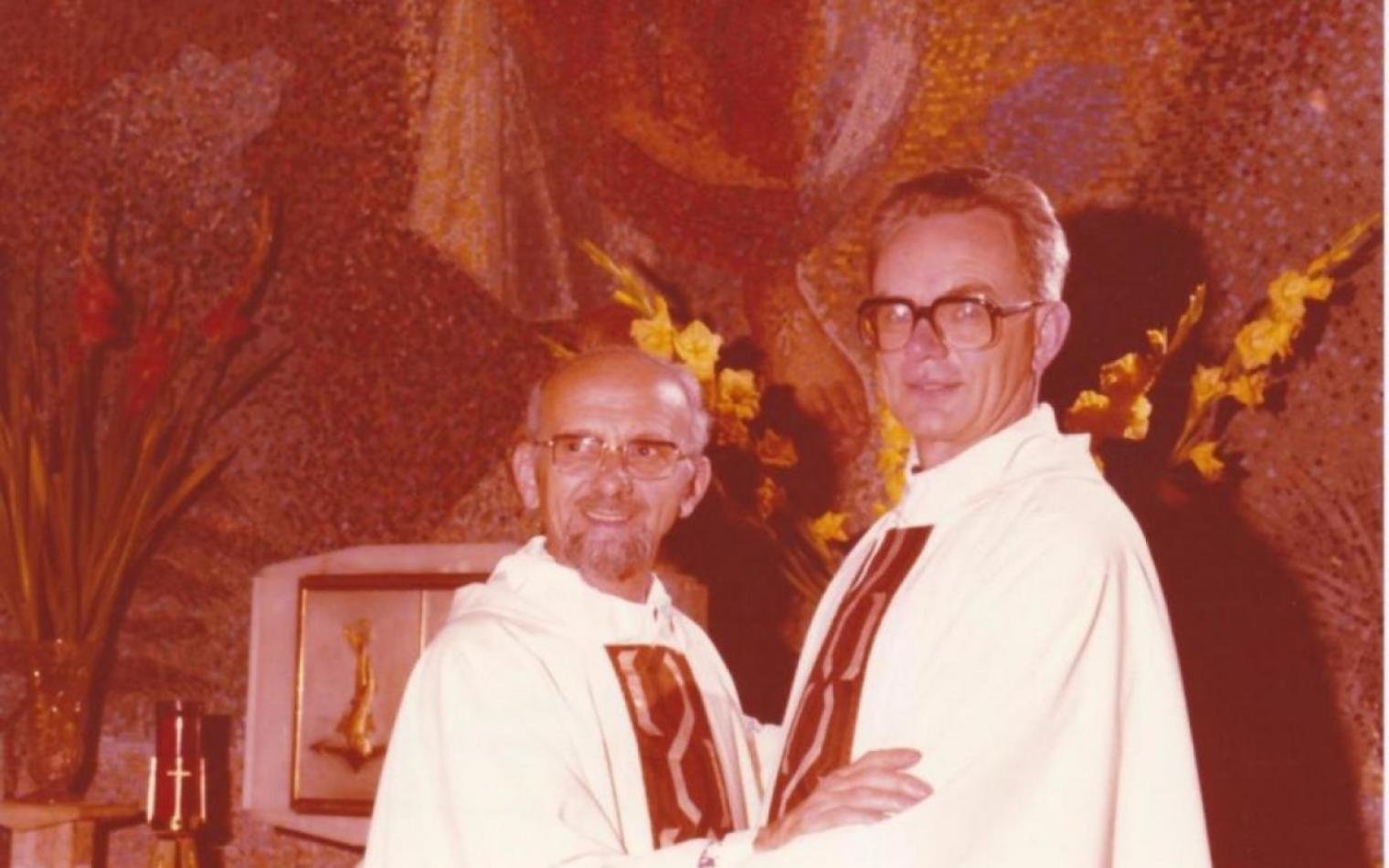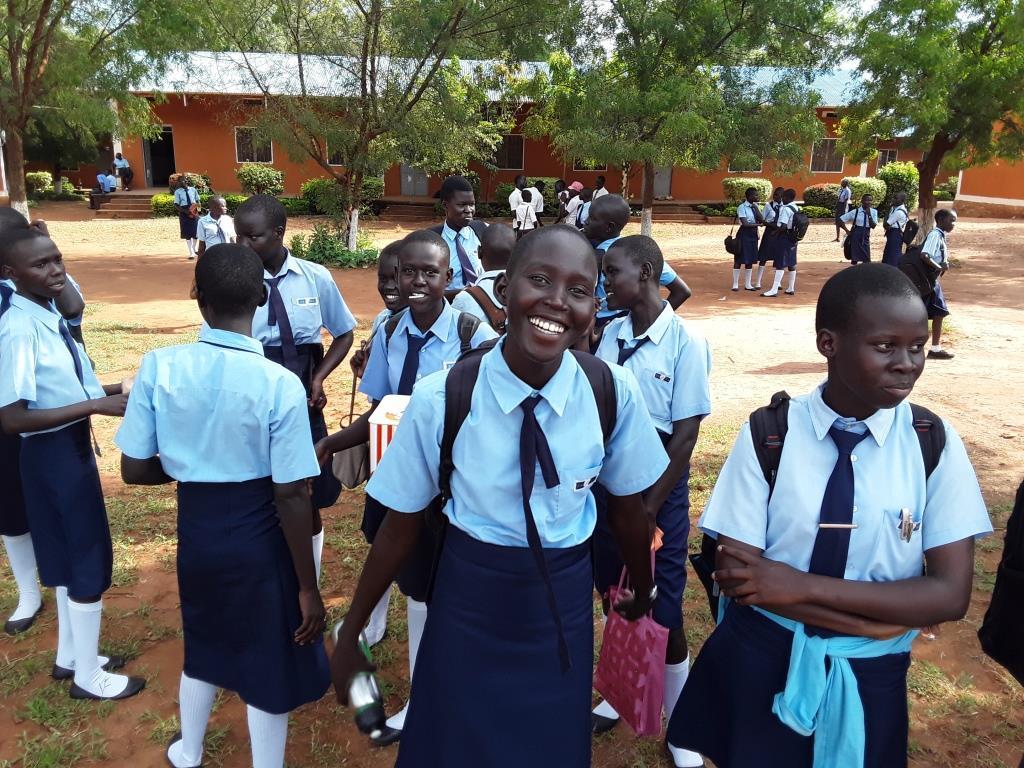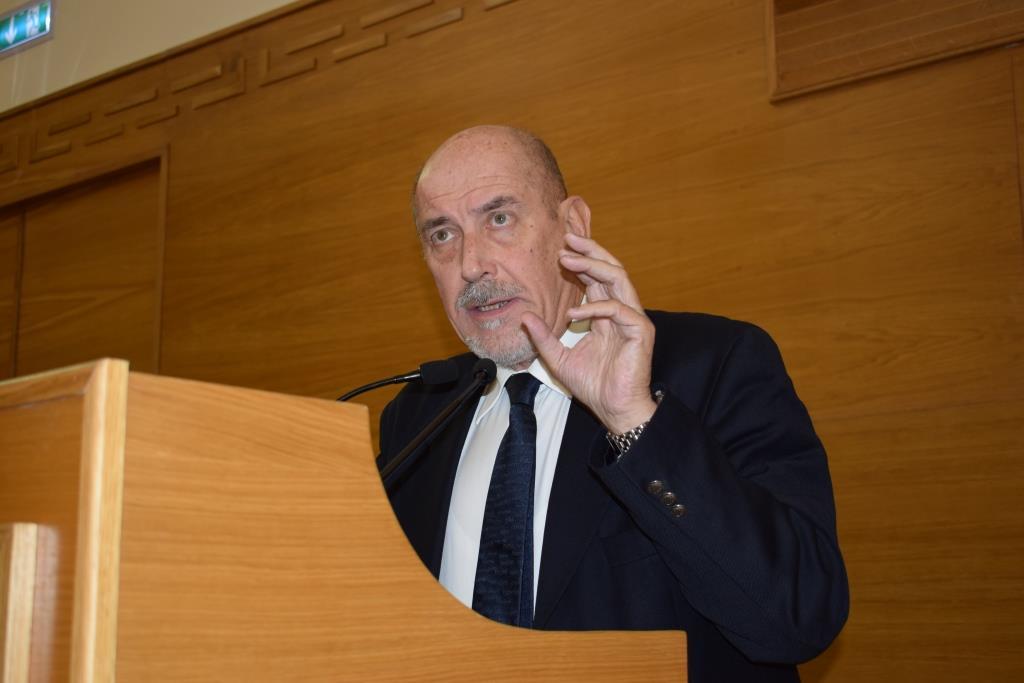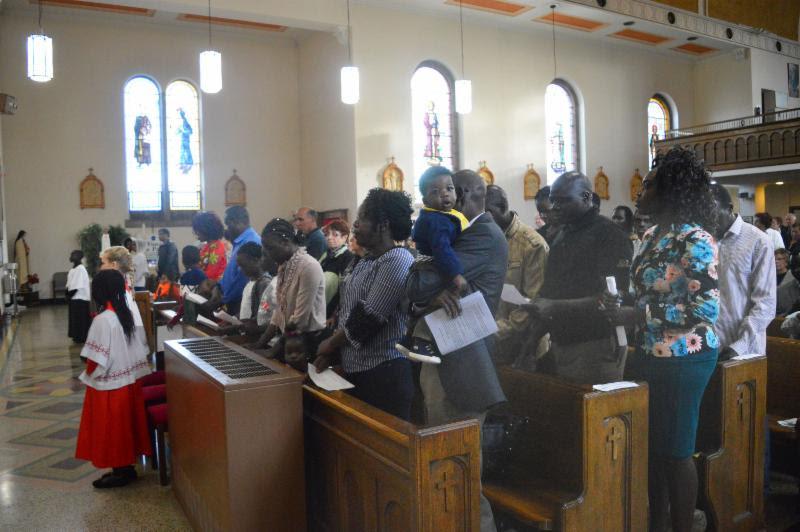Daniel Comboni
Comboni Missionaries
Institutional area
Other links
Newsletter
Wednesday, July 19, 2023
The 27th of July 2023 marks the centenary of the splitting of the Comboni inheritance, with the signing of the document with which Propaganda Fide made official the division of Daniele Comboni’s inheritance into two congregations: the Sons of the Sacred Heart of Jesus (FSCJ), with headquarters in Verona, and the Missionaries Sons of the Sacred Heart (MFSC), with headquarters in Brixen (Bressanone). [Photo of the two Superiors Generals, Fr. Tarcisio Agostoni and Fr. Georg Klose, on the day of reunification, feast of the Heart of Jesus, June 22, 1979 in Rome]
THE SPLITTING OF THE COMBONI INHERITANCE
A CENTENARY TO REMEMBER OR TO FORGET?
The 27th of July 2023 marks the centenary of the splitting of the Comboni inheritance, with the signing of the document with which Propaganda Fide made official the division of Daniele Comboni’s inheritance into two congregations: the Sons of the Sacred Heart of Jesus (FSCJ), with headquarters in Verona, and the Missionaries Sons of the Sacred Heart (MFSC), with headquarters in Brixen (Bressanone). Propaganda Fide had come to this decision on 27th November 1922, in plenary session[1]; but it waited to make it public, once the question of a mission territory for the MFSCs had to be first been resolved (this was done by the assignment to the MFSCs of the Apostolic Prefecture of Lydenburg, in South Africa).
A centenary, this one, certainly may not be celebrated, but nevertheless to be remembered for two reasons: first, to understand how this split came about (the causes, the protagonists of this turning point); and, secondly, to learn the lessons that must be learnt from this stage in the history of the Institute and from the sometimes tumultuous coexistence of the various cultures and souls that make up the Comboni heritage.
The historical context
The reader who is familiar with the development of the Comboni Institutes from their foundations (on 1st June 1867 for the Comboni Missionaries; on 1st January 1872 for the Comboni Missionary Sisters) until the year 1923[2], will find the outcome of the division (we prefer to speak of reconfiguration[3]) surprising and abrupt.
The unexpected death of the founder Daniele Comboni (10th October 1881, in Khartoum) left his legacy in a situation of uncertainty that is overcome with the first reconfiguration: that is, with the transformation of the Missionary Institute founded by Comboni into a Religious Congregation, at the hands of the Jesuits of the Refoundation, in Verona, in 1885[4] . Towards the end of the 19th century, Comboni’s male heirs appeared internally consolidated, with two important steps: they took over the direction of the Institute, which had become a religious congregation; and held its first general chapter (1899). The FSCJ number 91 missionaries: 21 priests, 42 scholastics and 28 brothers.
In the meantime, the spread of the Mahdist revolution in Sudan (1881-1898) has wiped out the signs of the missionary presence in the country and of the Comboni foundations in Khartoum, in El Obeid and on the Nuba Mountains, leaving a group of Comboni missionaries prisoners of the Mahdi (first in El-Obeid, then in Omdurman). But the resolution of the revolution in favour of the British (1898) again opened the door to the presence in Sudan of Comboni’s heirs, with the return of the first FSCJs to Omdurman, in 1899, and the intensification of the Comboni presence in southern Sudan, under the leadership of an FSCJ, Mgr. Antonio Roveggio (appointed in 1885 to replace Mgr. Francesco Sogaro, Comboni’s successor in Khartoum and Apostolic Vicar from 1882 to 1894).[5]
Mgr. Roveggio died exhausted in Berber, on 2nd May 1902, but his premature death did not stop the development of the mission in the Vicariate, which was led by Mgr. Franz X. Geyer, who pushed the missionary presence towards the south of the Vicariate, as far as its border, northern Uganda (17th February 1910).
The first two decades of the 20th century were thus a time of intense development in Central Africa, also followed by the expansion of Comboni’s heirs in Europe: in addition to Verona, Brixen (Bressanone) and Trent, Brescia was opened and the FSCJ opened a community in England (Sidcup, in 1903, for the study of English) and in Austria (Messendorf, in 1908). In the second General Chapter (from 3rd to 12th October 1909) the FSCJ already numbered 127: 64 priests, 46 brothers and 17 students. In this chapter, as well as electing the General Directorate (Fr. Federico Vianello was elected superior general), they verified their life and mission and prepared the Constitutions that guide them (which were approved on 19th March 1910). By the third General Chapter, in September 1919, there were 150.
Unresolved issues
This external context of favourable development, both in Europe and in Central Africa, did not help Comboni’s heirs to find an outlet for the unresolved issues left by the first configuration of the Comboni Institute as a religious congregation or which emerged in later years. On the contrary, it seems that the growth of the FSCJs, in Africa (with the expansion into southern Sudan and the creation of a new vicariate) and in Europe (with the affirmation of the formation given in Brixen and Austria) intensified them.
Let us briefly review these issues. First, the difference of views between the FSCJ religious missionaries and the Comboni missionaries, i.e., the priests who did not join the religious congregation and continued to work in the Central African Vicariate, both in Cairo and Khartoum (different views on mission priorities: baptise or promote, regenerate?). Second, the formation and involvement of the laity (brothers) in the mission. Third, the relationship between religious authority (the superior of the religious community in the mission) and apostolic authority (the Apostolic Vicar responsible for the apostolate in the missions). Fourth, the unrelenting tendency of missionaries to cluster along cultural or ethnic lines, in Africa as well as in Europe, and the consequent emergence of leading personalities who ride the waves (generally of dissatisfaction) and become personalities of reference for each group. Fifthly, the succumbing to the nationalist spirit and mutual prejudices between the various groups of missionaries (not even Fr. Colombaroli’s insistence on fraternal charity has succeeded in marginalising this corrosive element of coexistence among FSCJ missionaries).
The protagonists
It is not only the unresolved issues that weigh in the events that lead to the unravelling of the Comboni legacy; in reading these pages of Comboni history, the role played by some prominent personalities emerges. Let us recall the most important ones.
First, the missionary Franz Xavier Geyer, the dynamic superior of the community of Brixen, under whom the Comboni presence in this city knows a time of expansion and development, and who (finally) is elected Comboni’s successor in Khartoum and Apostolic Vicar (consecrated bishop on 8th November 1902, in Munich). To him we owe the development of the Central African mission to South Sudan and North Uganda. But he was also responsible for a move that greatly influenced the process we are analysing: the grouping of missionaries according to nationality. In the external reorganisation of the Central African mission, already in 1913, Archbishop Geyer proposed the creation of groups of missionaries according to nationality, with missionaries assigned to specific vicariates: the German-speaking ones to the Vicariate of Khartoum; the Italian ones to the Vicariate of the South.
The Superior General, Fr. Vianello, who was initially opposed to this proposal, had to give way, in part, by accepting that, without undermining the authority of the Superior General over all the missionaries, the Germans should be assigned mainly to Khartoum, under Mgr. Geyer, and the Italians to the Apostolic Prefecture of Bhar El Ghazal, under Mgr. Stoppani. As events unfolded, Mgr. Geyer became the catalyst for the group of German missionaries in Khartoum and, leaving the Vicariate in 1922 after an intense life spent on its development, he sided with this group that advocated division and total independence. In the report he prepares for Propaganda Fide and personally presents to Cardinal Van Rossum (April 1922) he says that in his heart he cannot blame those in Khartoum and his pro-division stance.
A reading of the correspondence between the Apostolic Vicar and the Superior General, for the agreement of 1913, shows that the religious superior of the FSCJs in Khartoum, Fr. Paolo Meroni, ended up supporting the proposal of the division into groups, for reasons of his own and opposed to those of Geyer, reflecting the difficulties of understanding between the two missionaries.
With Fr. Paolo Meroni we come to the second prominent figure in this affair. The Superior General Fr. Vianello called him to Verona as General Secretary, to take care of the organisation of the third general chapter, the first after the war, which took place in 1919. At this chapter, Fr. Meroni was elected Superior General. Towards the end of the chapter, “Father Alois Wilfling proposed that a province be created for the German-speaking houses: the chapter approved, and the president (Father Meroni) assured them that it would be dealt with as soon as the political horizon was clear.”[6]
In September 1921, Father Meroni promoted a survey among the Austro-Hungarian and German FSCJs (20 replies in favour of the creation of the province, 5 against, 3 null votes). But not even in the face of this result did he carry out the chapter decision, closing himself off in the conviction that the creation of the province was an unbearable burden for the Congregation. Instead, he sought a radical remedy: “to put the Austro-Germans before the alternative of complete absorption (suppression of the existing formation houses to give all members a single formation in the common novitiate) or complete separation.”[7]
Meticulous and persistent as he was, Fr. Meroni did not impose his view but, rather, waited for it to emerge as a need arising from the complex situation of the missions and the congregation, and/or from the missionaries themselves – which was to happen when Fr. Kauczor wrote a letter from Khartoum (on 2nd February 1922), defending the separation and passing it off as the wish of the missionaries of Khartoum. The sensitivity of the German-speaking FSCJ group in Khartoum seems, in fact, to play a role in the progress of the process leading to the division, so that the group can also be considered as protagonist in the affair.
By 24th January 1922, however, Fr. Paolo Meroni had already completed his report to Propaganda Fide and left Verona for Rome, where he remained until June, to plead his cause. His action proves effective, as he succeeds in changing Propaganda Fide’s opinion. The Cardinal Prefect, Van Rossum, in the first meeting still expresses himself in favour of the constitution of a German province and against the division; later, he writes a letter to Fr. Meroni with questions about province/separation to be sent to all the FSCJs, which Fr. Meroni disputes, claiming that the Italian side is unaware of the issue.
In April, Van Rossum also meets with Bishop Geyer and a change of opinion regarding this process takes place. The way is open for the presentation of the problem in the plenary session of the cardinals in November 1922 and the following steps taken in the first part of 1923. It is surprising that Propaganda Fide, which had traditionally accompanied Comboni affairs closely, both in Africa and in Europe, taking its time, changes its opinion in a short space of time and on the opinion of two of the protagonists, thus adding itself to the list of the protagonists of this affair with the decree of 27th July 1923.
External influences
Some external elements, in the political sphere, also played a role in the process that led to this split. It is only right to recall them, albeit briefly. The first, the so-called interference of the Austro-Hungarian government on the Vicariate of Central Africa. An interference facilitated by the protection demanded by the missionaries, practically from the beginning of the vicariate,[8] and which offered Austria space to seek diplomatic influence in a strategic geographical space, already disputed by the British over Egypt and Sudan and by the French over the territories of Palestine and with the protection of the Holy Places.
The second, more decisive external element was the outbreak of the First World War (1914-1918) that saw Germany and Austria on one side against England and Italy on the other. The impact on the FSCJs was negative in a double way: on the one hand, it exasperated the feelings of patriotism connected with the respective nationalisms, adding tension to the relations between Italian and German missionaries; on the other hand, while the Italian missionaries in Cairo and Sudan can continue their activities, the German missionaries encountered increasing difficulties (they are, in fact, taken prisoners and brought to camps). With the end of the war this situation was maintained and worsened for the German missionaries, who were unwanted and disliked by the British authorities.
The Great Forgotten
The reader of this Comboni history (from 1895 to 1923)[9] and of this surprising outcome of the Comboni inheritance, even the most distracted, is surprised to find no mention, no reference to Daniele Comboni. The great missionary of central Africa, founder of the Comboni Institutes, is the great absentee in this whole affair and in the folds of history that led his heirs to it.
Not that his position on the issues that led to this second reconfiguration of his institute was not clear to him: his ideal of the institute as a cenacle of apostles accentuates the communitarian dimension of evangelisation, a mission to be carried out in fraternity, beyond the cultural and ethnic origins of each missionary; the accent on the catholicity of the mission and its work was clear enough not to be forgotten in the hour in which it had to be kept in mind; the invitation to each missionary to be a hidden stone[10] warded off any temptation to leadership and the search for popularity and domination over others; the ideal of a mission lived in collaboration and subsidiarity, in the convergence of different ministries and charisms,[11] was the antidote to any ‘factionalism’; the conviction that “the work must be Catholic, not Spanish, French, German or Italian”[12] warded off any nationalism.
Of course, this is not the time to clarify the reasons for this forgetfulness of Daniele Comboni. It is sufficient for us to point out how far one was from the sentiment and attitude of those who took up and lived under the banner of Daniel Comboni’s testimony: “When difficult moments arise, then I ask my unforgettable Episcopus Daniel for advice and I think: what would he do and how would he answer me. Moreover, there is the promise, which six hours before his death he received from me, and this is for me a sacred bond.”[13]
Forgetting Daniele Comboni has led to forgetting Comboni’s methodology for missionary discernment: “When evening comes, and night falls, we hold a council on how to escape from the difficult situation. We make suggestions, we discuss, we pray”[14] (“vademecum of solidarity between believers who share the same undertaking” and seek a solution[15]). It is surprising that the reconfiguration of the Institute took place without the convocation of a general special chapter and without the consultation of the FSCJs.
At the General Chapter that followed, in 1925, the person who was largely blamed by history for the division, took it in these words: “A point had been reached where it was no longer possible to go forward – I do not intend to blame anyone for this state of affairs. The separation was a necessity to save the Institute: it was absolutely necessary that the two parts, which already existed within the Congregation, like Esau and Jacob while they were in their mother’s womb, come out and each have their freedom of life and movement. It was a painful step: a case of dura lex sed lex. It was two years of torment and anguish for the leaders of the Institute. But it was salvation for all. Now, the Germans have constituted themselves into a flourishing congregation; to them, I, interpreting the sentiments of all, send greetings and best wishes for a prosperous life; and our fundamental institute in Verona now finds itself restored to itself and to a new life”[16].
Comboni history, however, has its surprises... and its irony: Fr. Paolo Meroni is also the person who decides on the introduction of Daniele Comboni’s cause for beatification.[17] The process of historical research and the rediscovery of the Founder has brought the FSCJ and MFSC back on a path of reunification, which took place and was sealed in the General Chapter of 1979 – an event that the heirs of Daniele Comboni (now baptised MCCJ) consider a grace, this one to be remembered and celebrated, in the memory of the founder recognised by the Church, in the canonisation of 2003, as a master of Christian life and mission.
Conclusion: learning lessons
By way of conclusion, it is not out of place to ask ourselves what lessons we can learn from revisiting (albeit briefly, as we do here) this page of Comboni history. Let us indicate some of them, leaving it to the interested reader to identify others.
First: problems, wherever or however they arise, are to be solved; if not, they tend to become loose land mines that can explode at any moment when touched by the surprises of history.
Second: unity and communion are not to be taken for granted in the intercultural context in which we live; they can be tested by many elements (cultural, linguistic, political, social, ecclesial...). The Church of our time reminds us that only the synodal context of mutual listening can guarantee the discernment and preservation of communion and unity.
Third: the exercise of authority must be regulated and carried out according to clear rules and the principles of subsidiarity and respect for competences; trampling on rules never augurs well, as we see in this process (extra-ordinary chapter not convened, decisions not executed, meetings of the general council done without minutes, etc); an end considered good cannot justify the temporary cancellation of procedures.
Fourth – and most fundamental – lesson: in resolving disagreements, one must always return (to the Gospel, certainly, and) to the founder and the founding charism, which are a guarantee of fidelity and a source of fruitfulness.
16th July 2023
Fr. Manuel Augusto Lopes Ferreira, mccj
[1] “On 27th November, the Sacred Congregation of Propaganda Fide decided, in plenary session, “to completely separate the Italian side from the Austro-German side”, after the settlement of all economic issues of any kind between the two parties, and appointed Father Filippo Maroto, of the Missionary Sons of the Immaculate Heart of Mary (Claretians) as its delegate in the resolution of the aforesaid issues.” VITTORINO DELLAGIACOMA, History of the Institute from 1881 to 1937. Manuscript, General Archives, Rome.
[2] We indicate some sources for any interested readers: REINHOLD BAUMANN, The Comboni Missionaries in Germany, Austria and South Tyrol, Rome, 2013, pages 1-30; VITTORINO DELLAGIACOMA, Eredità del Comboni-Storia dell’Istituto dal 1881 al 1937, manuscript kept in the General Archives in Rome, will be published in the next issue of the journal Archivio Comboniano, LIV, year 2024. TARCISIO AGOSTONI, The Comboni Missionaries-An Outline History 1867-1997, Rome 2003, pages 207-232.
[3] Some authors speak of separation, others of division. In this text we prefer to use the word “reconfiguration”. Daniele Comboni’s legacy exists, in fact, in a dual mode, conditioned by ethnic and cultural factors.
[4] For this phase of Combonian history see ALDO GILLI History of the Combonian Institute from the death of the Founder to the change in Religious Congregation 1881-1885, Rome 1981.
[5] For the history of the mahdia, see CAMILLO BALLIN, Il Cristo e il Mahdi, EMI 2001, and JOSEF OHRWALDER, I miei dieci anni di prigionia, EMI 1998.
[6] VITTORINO DELLAGIACOMA, work cited, p. 14.
[7] VITTORINO DELLAGIACOMA, cited work, p. 15.
[8] As early as 1852, Bishop Knoblecker sought official protection from Austria over the Vicariate.
[9] VITTORINO DELLAGIACOMA, History of the Institute from 1881 to 1937. Manuscript, General Archives, Rome.
[10] DANIELE COMBONI, The Writings, number 2701.
[11] Clear dimensions in the founding documents: Plan for the Regeneration of Africa (1864) and in the Circular Letter to the Council Fathers (1870); Rules of 1871. See JOAQUIM V. DA CRUZ, Between Loyalty and Alienation: The Comboni Charism in History, in Archivio Comboniano 46, 2088, pp. 109-164.
[12] DANIELE COMBONI, ‘Regenerating Africa with Africa’, in Museo delle Missioni Cattoliche 8 (1865), pp. 18-32.
[13] JOHAN DICHTL, Letter to Mitterrutzner, from Khartoum in January 1883, in CPAE, Dichtl 09.
[14] DANIELE COMBONI, The Writings, 261.
[15] MARIO TREBESCHI, La Missione come Pellegrinaggio, in San Daniele Comboni, pp. 45-46.
[16] PAOLO MERONI, Superior General of the FSCJ. “Report on the State of the Congregation,” made at the Fourth General Chapter held in 1925. Comboni Archives Rome, Box 272, 4, IV General Chapter, Annexes to the Minutes.
[17] PAOLO MERONI, Circular Letter Introduction to the Cause of Beatification of our Founder, Mgr. Daniele Comboni. Verona 19/03/1928.




